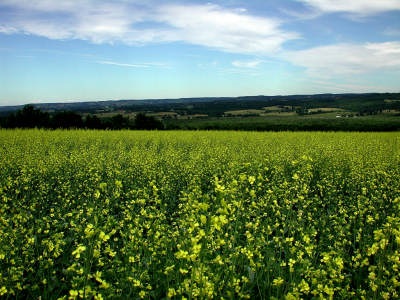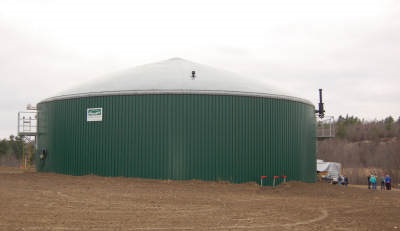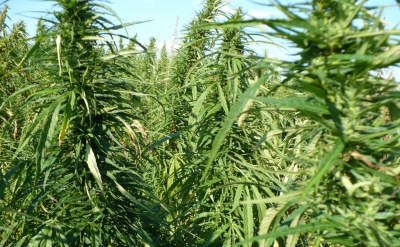Introduction to bioproducts
Information on bioproducts, why you might want to grow them and the categories of bioproducts.
Definitions
Bioproducts are products made with some component of biological or renewable materials
There is no universally accepted definition of « bioeconomy », however, it can basically be described as an economy based on the sustainable manufacture of products, in whole or in part, from renewable resources. It includes all processes, from feedstock production through the processing stage(s) to the manufacture of end products, in addition to research, development and commercialization processes.
Typically, bioproducts are divided into three categories:
Bioenergy
- liquid fuels such as ethanol and biodiesel
- solid biomass for combustion to generate heat and power
- gaseous fuel such as biogas and syngas, which can be used to generate heat and power
Biomaterials
- bioplastics from plant oils and sugars
- biofoams and biorubber from plant oils and latex
- biocomposites manufactured from agricultural (for example, hemp, flax, kenaf) and forestry biofibres, used, for example, in the production of automobile door panels and parts
Biochemicals
- industrial - basic and specialty chemicals and resins, including paints, lubricants and solvents
- pharmaceuticals - antibodies and vaccines produced by genetically modified plant « factories » and natural source medicinal compounds
- biocosmetics - soaps, body creams and lotions
Why bioproducts?
Farmers in Ontario have traditionally produced food and feed crops that are often subjected to significant price fluctuations, overproduction and high input costs (such as fertilizer), resulting in marginal economic returns.
The emerging bioeconomy offers the potential to contribute significantly to the overall economies of both Ontario and Canada. The manufacture of bio-based products provides the opportunity to benefit all participants in the value chain, offering farmers and food processors additional markets for commodities and byproducts. In particular, primary producers may realize increased economic gains from bio-based materials derived from products that they generate, many of which have been considered « waste » materials in the past.
Farmers may be able to further benefit from the bioeconomy through participation or ownership positions in various components of the value chain.
Bioproducts development can offer economic, environmental and health benefits.
Some benefits of bioproducts
Socioeconomic benefits
- a diversified and stable bioeconomy sector that strengthens Ontario's overall economy
- farm diversification resulting from additional uses of agricultural feedstocks
- development of new industries and products
- increased economic opportunities for rural communities
- reduced dependence on non-renewable fossil fuels
Environmental benefits
- reduced greenhouse gas emissions in the manufacture of some bioproducts, compared to petroleum-based equivalents
- increased safety for the environment, reduced toxicity and more biodegradability
- sustainable production of renewable feedstocks
Health benefits
- potential production of inexpensive medicinal drugs and vaccines
- development of new drugs not available from traditional sources
Categories of bioproducts
Bioenergy
Bioenergy is produced in liquid, solid or gaseous forms when biomass is treated, using different physical, biochemical, thermochemical and other processes.
Ethanol
Ethanol and biodiesel are the two most common biofuels often blended with petroleum-based gasoline or diesel, respectively, for use as transportation or heating fuels. Currently, corn and wheat grains are the two main feedstocks for ethanol production in North America, with corn being the main feedstock for ethanol produced via a biochemical fermentation process.
As of 2009, approximately 685 million L of ethanol are produced annually in Ontario. Common gasoline-ethanol blends include 5%-10% ethanol designated as E-5 and E-10. An E-85 blend can be used in Flex Fuel Vehicles (FFV). The Ontario government has mandated a 5% ethanol blend in gasoline as of January 1, 2007
New technologies to produce ethanol directly from cellulose or syngas (a mixture of carbon monoxide and hydrogen) are being evaluated. Currently, the cost of producing cellulosic or thermochemical syngas ethanol is high, compared to production from grain. Several companies in Canada, and globally, are actively researching these technologies in an effort to optimize reaction conditions for hydrolyzing cellulose into fermentable sugars, reducing overall production costs and maximizing ethanol yields. There is great interest in these technologies because of their flexibility to use a wide variety of biomass feedstocks.
Biodiesel
Biodiesel is commonly produced by the chemical conversion of vegetable oils, fats and greases by a process called transesterfication. Soybean and canola (Figure 1) are examples of oilseed crops that can be used in biodiesel production. Processing residues such as recycled vegetable oils from restaurants and fats from animal rendering can also be processed into biodiesel. Microalgae are photosynthetic aquatic plants that produce and accumulate significant amounts of oil that can be used for the production of biodiesel. Research is ongoing to scale up algae production to an industrial level
Bio-oil or pyrolysis oil
Bio-oil is produced by a pyrolysis process that involves the rapid thermal decomposition of organic materials such as wood and agricultural biomass, in the absence of oxygen
The quality of the bio-oil is dependent upon the type of biomass used. High-quality bio-oil has low water content and can be substituted for diesel, heavy fuel oil, light fuel oil or natural gas as a combustible fuel. In addition, certain bio-oils contain high value chemicals that have industrial or medical applications.
Several companies in Ontario are working on fast pyrolysis technology to convert biomass to bio-oil.
Biogas
Anaerobic digestion is a process in which organic materials such as manure, agricultural crop residues, dedicated energy crops and food processing residues are digested by bacteria, in the absence of oxygen, to generate biogas.
Biogas usually contains 50%-60% methane and 35%-40% carbon dioxide and can be burned directly in internal combustion engines to produce power and heat. Biogas can also be purified to produce high-quality methane for supplementing natural gas supplies.
Details on connecting to the grid and anaerobic digesters (Figure 2) in general are available on the OMAFRA website.
Bioheat
Biomass crops (switchgrass, miscanthus), agricultural crop residues, forestry and a wide range of organic materials can be combusted directly or densified into chips, cubes, briquettes, pucks and pellets (Figure 3), for direct combustion to produce heat and power. A switchgrass enterprise budget is available on the OMAFRA website.
In general, biomass pellets are used for residential buildings, commercial buildings or greenhouse heating. Because of fluctuations in natural gas and oil prices, some growers in the greenhouse industry are looking for alternative energy sources such as biomass combustion systems as a way of reducing energy costs. Biomass combustion generates heat and produces carbon dioxide, which is being explored for use in the greenhouse to enhance plant growth. The OMAFRA fact sheet Using biomass for heating greenhouses in Ontario is also available on the OMAFRA website. The potentially high biomass yields of dedicated energy crops such as switchgrass and miscanthus, have led some growers to investigate these opportunities in Ontario.
Biomaterials
Biocomposites and biofibres
Biofibres are renewable, biodegradable fibres produced from wood, agricultural crop residues and purpose-grown crops such as hemp (Figure 4), flax and kenaf. Industrial hemp is a regulated crop in Canada and requires a licence for production. More information on industrial hemp licensing and regulations is available on the Health Canada website.
Biofibres are now used in the production of structural components (for example, stairs, decking, doors and shelves), and for the construction and furniture industries and can be used in the manufacture of high-quality paper and textiles
Biofibres can be blended with petroleum-based polymers and resins to produce stronger, more durable biocomposite materials, which have a range of applications in the automotive (for example, door panels), aerospace and other manufacturing sectors.
In Ontario, several initiatives exist that are designed to foster research and commercialization of biofibres and biocomposites for use in the automotive sector (for example, BioAuto Council and the BioCar Initiative, a multi-university project).
Bioplastics
Bioplastics are polymers produced from starch crops (for example, corn, potatoes, wheat) and vegetable oils (for example, canola or soybeans), rather than petroleum feedstocks. For example, corn starch can be biochemically processed to lactic acid, which is then chemically converted to polylactic acid for use in the production of bioplastics
Bioplastics are biodegradable and are being adopted for a number of applications in the packaging, cutlery, gardening and pharmaceutical industries. Pricing of plastics is directly tied to crude oil cost, further increasing interest in the production of bioplastics.
Biochemicals
Industrial
A number of industrial chemicals traditionally produced from petroleum can be produced from plant sources. Vegetable oils from corn, soybean and canola can also be used as feedstocks for the manufacture of chemicals such as solvents, lubricants (Figure 5), waxes and adhesives.
Biological or chemical processing of plant starches such as corn starch can produce organic chemicals such as acetic acid, succinic acid, glycerol and methanol, all of which are important feedstocks for the manufacture of high-value, bio-based materials and biochemicals
Biopharmaceuticals
Biopharmaceuticals are plant-derived compounds, such as vaccines, antibiotics and drugs, that have medicinal value. Plants can be modified genetically to produce a range of valuable biopharmaceutical compounds and industrial enzymes. The production of medically active compounds in plants could greatly reduce production costs, making them more widely available to the public. For example, there are commercial efforts in Canada to produce insulin from safflower for the treatment of diabetes
Cosmetics
A number of items such as body creams, soaps, vegetable oil-based lotions and herbal extracts can be manufactured from plant-based materials. Vegetable oils, starches, proteins and their derivates can be used as primary raw materials for the manufacture of a number of personal care products that are part of daily life, including deodorants, shampoos, skin care products, make-up, sunscreens, beauty and personal hygiene products. The annual markets for cosmetics and personal care products in Canada is around $5.4 billion
For more information
The OMAFRA website provides information related to bioproducts and the bioeconomy, covering such topics as bioenergy, biofuels, bio-materials, biochemicals, conferences and meetings and other related subjects.
This fact sheet was written by Mahendra Thimmanagari, Crop Bioproducts Specialist, OMAFRA, Guelph; Ian McDonald, Applied Research Coordinator - Field Crops, OMAFRA, Guelph; Jim Todd, Transition Crops Specialist, OMAFRA, Simcoe.
Footnotes
- footnote[1] Back to paragraph Primer on Bioproducts, pollutionprobe.org
- footnote[2] Back to paragraph Ontario Ministry of the Environment, Conservation and Parks
- footnote[3] Back to paragraph Canadian Renewable Fuels Association
- footnote[4] Back to paragraph A Look Back at the U.S. Department of Energy's Aquatic Species Program: Biodiesel from Algae
- footnote[5] Back to paragraph Biomass Pyrolysis: IEA Bioenergy
- footnote[6] Back to paragraph Non-Food/Non-Feed Industrial Uses for Agricultural Product, greenfuels.org
- footnote[7] Back to paragraph U.S. Department of Energy
- footnote[8] Back to paragraph Canadian Cosmetic, Toiletry and Fragrance Association




